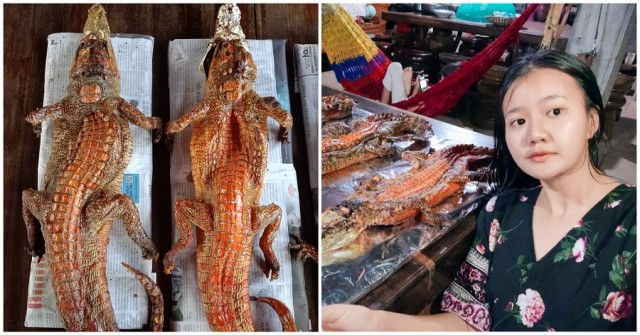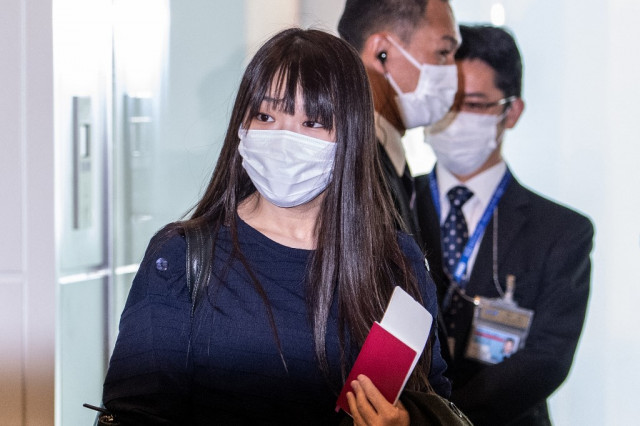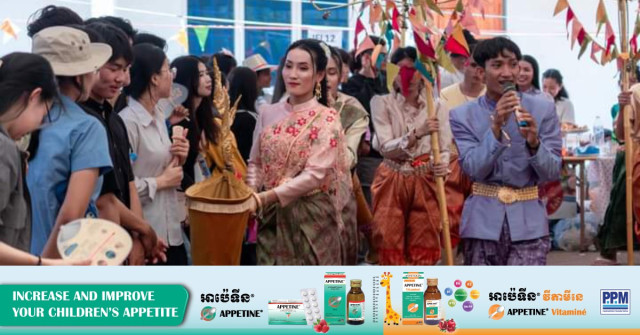King Norodom Sihanouk and Cambodia caught in the Cold War
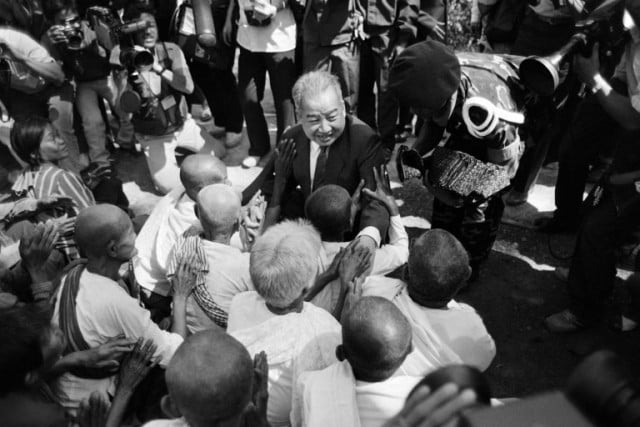
- By Michelle Vachon
- November 24, 2022 2:25 PM
PHNOM PENH – On Nov. 24, 1989, Australian Foreign Minister Gareth Evans submitted a peace agreement proposal for Cambodia that involved the United Nations overseeing the country to stop the civil war, hold national elections in a safe and democratic way to select the country’s leaders, and at last restore normalcy.
This was the first step 30 years ago that would eventually put an end to two decades of hardship for Cambodians in and out of the country, ending the shortage of everything for those who had stayed put in January 1975 when the Vietnamese army and Cambodian contingent had forced the Khmer Rouge to flee to the Thai border. And it would enable to go home those who had found themselves in Thailand either to escape the combat zones or because they were pushed to the border against their will. By the end of November 1992, 200,000 refugees had come back to the country, and within five months 160,000 more would return.
Following Gareth Evans’ agreement proposal, it would still take nearly two years for the Cambodian parties involved and the superpowers supporting them to outline the terms and sign on Oct. 23, 1991, the Paris Peace Agreements that would at last start the process of rebuilding the country.
The story behind the story that led to the final version of the peace agreements went back decades. And involved people on several continents who came to meet because of the late King Norodom Sihanouk whose 100th anniversary was celebrated on Oct. 31, 2022.
King Sihanouk answering an inquiry from a student on the other side of the planet
This also included a man from Chile in South America who had immigrated and studied in Australia in the 1970s and would come to serve as the late king’s secretary in the 1980s and his biographer afterwards.
“I was 16 years old when I read about the visit of Jacqueline Kennedy [the wife of U.S. President John Kennedy] to Cambodia in November 1967,” Julio Jeldres said in an interview. Curious about the country she had visited, he tried to learn about it. The librarian at the American Institute in Santiago, Chili’s capital where he lived, gave him the address of the Cambodian Mission to the United Nations in New York City as Cambodia had no embassy in South America. So Jeldres wrote to the mission in Spanish—the only language he spoke at the time—requesting information on a country on the other side of the planet, which, in the days prior to the internet, was very far indeed.
Four months later, he received a message from the palace. His letter had been shown to Prince Sihanouk, who was then Cambodia’s head of state. The prince wrote to him that he was glad to see a Chilian student interested in his country and would have information on Cambodia sent to him. Four more months later, Jeldres received enough books on Cambodia to fill a library. Many of these books were in French, so Jeldres had to convince his father to pay for him to take French lessons. Also, he and his friends formed a group to study Cambodia.
In the meantime, Australia opened an embassy in Chili. The ambassador was Noel Deschamps who had been based in Cambodia for about 7 years. Prince Sihanouk had told him about Jeldres and, when he arrived in Chili, he contacted him. Deschamps had a huge collection of slides and films on Cambodia, and would show them to the students at his residence. “Noel Deschamps was a different kind of ambassador,” Jeldres said. “When he left Chili, all the drivers of diplomatic missions organized a farewell party for him because he always took care of everyone.”
When Prince Sihanouk was ousted from power through a vote in parliament in 1970 and, based in Beijing, became the official head of the Khmer Rouge, “[he] sent us information all the time in French,” Jeldres said. The Chinese news agency Xinhua would also release to the press in Chili his speeches translated into Spanish, he said.
The Khmer Rouge years
The Khmer Rouge seized power in Cambodia in April 1975. Prince Sihanouk expected to immediately return to Phnom Penh but this was not so. “The Khmer Rouge started to put obstacles for his return,” said Jeldres. “Everything started to work against Prince Sihanouk at the time.
“His main supporter in the Chinese government was [Premier] Zhou Enlai who, at the time, was seriously ill with cancer of the liver and, although he was still operating as premier, had lost a lot of authority,” Jeldres said. “And the Gang of Four [Chinese political leaders] supported the Khmer Rouge. They did not support Prince Sihanouk.”
Prince Sihanouk’s mother Queen Sisowath Kossamak died on April 27, 1975, in Beijing. “The king after the funeral moved to Pyongyang in North Korea.
“So he went to live there and waited to get the green light, I suppose, to come back to Cambodia,” Jeldres said. “It was then that the president of North Korea Kim II-Sung started to talk to the Khmer Rouge and put pressure on them to allow Prince Sihanouk to return because he felt that the prince was still the leader who could keep Cambodia together.
“I think that Kim II-Sung was not too convinced about the Khmer Rouge,” Jeldres said. “At that time Kim II-Sung was taking a more independent line with both China and Moscow. He couldn’t see on which side the Khmer Rouge [were] because the Khmer Rouge were very good at playing games. They had started [being] very close to the Vietnamese [who had helped them take control of Cambodia in the early 1970s.] And when they were in power, they had declared war on the Vietnamese.
“Still, Kim II-Sung finally invited a delegation in August 1975,” Jeldres said. “Khieu Samphan…came to Pyongyang. And he convinced [him] to allow Prince Sihanouk to return to Cambodia because it was not good for a head of state to live in a foreign country.
The king went back to Phnom Penh in September 1975 and then was sent to the United Nations in New York City. “The Khmer Rouge were very clever: They used the royal standard in their diplomatic relations because it helped them to get recognition from foreign countries,” Jeldres said. Prince Sihanouk returned to Cambodia in December 1975 and basically spent the Khmer Rouge regime under house arrest in the palace.
In January 1979, a Cambodian contingent backed by the Vietnamese army stopped the Pol Pot regime that had caused the death of more than 2 million people in less than four years. China that had supported the regime, and the United States that resented having lost the war in Vietnam, turned against the new government, and, as U.S. journalist Elizabeth Becker writes in her book “When the War Was Over,” the United States sided with China when China attacked Vietnam in retaliation in February 1979, and encouraged Thailand and China to support the Khmer Rouge who were based in Thailand. The two superpowers managed to have the defeated Khmer Rouge represent Cambodia at the United Nations in spite of some countries’ objections.
 Prince Norodom Sihanouk explains the geopolitical position of Cambodia in Southeast Asia with its strengths and weaknesses. Photo: AFP
Prince Norodom Sihanouk explains the geopolitical position of Cambodia in Southeast Asia with its strengths and weaknesses. Photo: AFP
“Central to the war—…who was punished, who was rewarded—was the international decision to ignore all charges of genocide and massive human rights abuse against the Khmer Rouge,” Becker writes. “The United Nations dropped its investigation.”
Prince Sihanouk, who had been sent to the United States to speak on behalf of the Khmer Rouge at the United Nations Security Council, had first thought of settling in the United States and then in France. But, as he would mention several times to journalists, he had no money. So, he went back to Beijing where his residence remained at his disposal. And, since China was asking him to work closely with the Khmer Rouge, which he was not willing to do, he would often stay in North Korea.
The concept that would eventually lead to the Paris Peace Agreements a decade later
“Prince Norodom Sihanouk has always been a daring diplomat,” Belgian journalist Jacques Bekaert wrote in July 1988 in one of his news articles. “[I]n June 1981, he told me what he has kept telling everyone wo cared to listen ever since: disarm the Khmer factions and bring in [a U.N.] international peacekeeping force.
“He did a lot of manoeuvring in the past few years, adjusting to changing realities, or more often provoking some movements,” Bekaert wrote. “But he stuck to the idea that nothing good would come of any plan that did not provide for the demilitarisation of the country.”
By then, Prince Sihanouk, who would become the country’s king for the second time in his life in 1993, truly was a veteran diplomat with an understanding not only of the motives of Cambodia’s numerous faction leaders but also of regional and international politics. In 1961—a time when the world was divided between the Western Bloc, which included the United States and several European countries, and the Easter Bloc led by the Soviet Union—Prince Sihanouk had had the country join the Non-Aligned Movement.
Fully aware that Cambodia’s war in the 1980s had become an extension of the superpowers’ conflicts, Prince Sihanouk believed that only the intervention of the United Nations could bring peace to the country.
This is why when they first met in 1981 in North Korea, he asked Julio Jeldres to help him outline in English a peace plan involving the United Nations. At the time, Prince Sihanouk often stayed in North Korea as China was asking him to work closely with the Khmer Rouge based in Thailand, which he was not willing to do.
Jeldres had relocated to Australia in 1972 where he had obtained a university degree in Asian studies and was working for the Ministry of Immigration and Ethnic Affairs.
“When I read that Prince Sihanouk was in New York [in January 1979], I sent him a telegram,” he said. “I just addressed it: Prince Sihanouk, United Nations, New York. Because I didn’t know where he was staying or anything. He got it and replied by telegram as well.”
After all those years, Prince Sihanouk still remembered him. So, they started corresponding. “Then I told him that I was going to Hong Kong in February 1981,” Jeldres said. “This was going to be the first time I was leaving Australia since I had come from Chili. I had won in a raffle a round-trip ticket to Hong Kong on Cathay Pacific.”
Jeldres wrote that he was sorry he would not see the prince in Beijing since he now was in North Korea. “Then I got a telegram saying the [North Korean] president is inviting you to North Korea: ‘Everything will be taken care of for you so that we can meet,’ Prince Sihanouk said…It was very difficult to get visas for China at that time—we are talking of 1981, you know. And so, they sent me all the information.”
However, going to North Korea was no small matter. “You had to be officially invited: It was the only way,” Jeldres said. “First, I had to get the visa for China. Once there, the king had told me to go to the North Korean Embassy and tell them I was King Sihanouk’s friend. Then they would give me a visa and a plane ticket for Pyongyang.”
Things more or less went according to plans. “It was February 1981, and it was freezing in Beijing,” Jeldres recalled. “I went to the North Korean Embassy: a huge embassy in the Soviet style. I said, ‘[m]y name is Julio Jeldres. I am the friend of King Sihanouk from Australia, and he told me to come here and get a visa to go visit him.’ He was adamant that there was no visa for me. I thought what am I going to do now; I had come all the way to China.” Back to his hotel, Jeldres asked the receptionist whether he could call North Korea. He did not even have a phone number, so he told her to ask for Prince Sihanouk. “The prince answered the phone himself: It was the first time I was talking to him,” Jeldres said. “He said, ‘No, no, no. You must not say that you are my Australian friend. They are expecting my Chilian friend.’
“So, the next morning, I went back to the North Korean Embassy to see the same man I had seen the day before and said ‘I’m the Chilian friend of Prince Sihanouk.’ He replied ‘Ah, we have been expecting you.’” Even though Jeldres was carrying an Australian passport, North Korean officials would keep on referring to him as Chilian during his stay as there was no diplomatic relations between Australia and North Korea.
“I believe there was only one flight a week from Beijing to North Korea at the time,” Jeldres said. “And on the flight, there were foreign diplomats and the journalist Nayan Chanda [diplomatic correspondent of the Far Eastern Economic Review] who was going to interview Prince Sihanouk. Prince Norodom Sihamoni [today’s King Sihamoni] came to meet me at the airport.”
During the first three days of his visit, Jeldres stayed at a hotel as the guest of North Korea’s President Kim Il-Sung and visited sites according to a schedule set by the government. Afterwards, he moved to Prince Sihanouk’s residence.
The first time they met, Prince Sihanouk embraced him and said, “Oh, my good friend, I wanted to meet you for a long time,” Jeldres recalled.
His visit lasted 18 days. Before he left, Prince Sihanouk asked him whether he could help him translate from French to English a proposal for a peace settlement he had written and, if possible, pass it on to government officials in Australia. The text outlined the terms of a peace agreement for Cambodia that would involve the United Nations and a peacekeeping force, Jeldres said.
When he returned to Australia, he contacted Noel Deschamps, the Australian ambassador he had met in Chili and who had since retired. Deschamps agreed to help write the proposal and forward it to the Australian government. And since his visit to North Korea had drawn government’s attention, Jeldres ended up speaking to people at the Australian Ministry of Foreign Affairs, which would play an important role in the conflict settlement.
Jeldres had also offered Prince Sihanouk to translate his letters and documents. So, the prince started to mail him texts that would take days to arrive and sending others by telegram that would often arrive in the middle of the night.
“I resigned from the ministry in September 1983, and in November 1983, I joined Prince Norodom Ranarridh [Prince Sihanouk’s son] in Bangkok,” Jeldres said. “By that time, the coalition government had been formed and Prince Sihanouk had been given a budget by ASEAN. The Chinese and the United States were also helping, which had made it possible to set up an office with Prince Ranarridh heading it.”
The long civil war that affected Cambodians on both sides of the border
“The continuing conflict was incredibly complex, being played out at three distinct levels,” said Gareth Evans, who was Australia’s minister of foreign affairs from 1988 to 1996 and played a key role in the process that led to the Paris Peace Agreements. “Internally there were four warring factions…Hun Sen's government waged [war] against a fragile coalition of the non-communist Sihanoukists and KPNLF [Khmer People's National Liberation Front headed by former Cambodian prime minister Son Sann] and communist Khmer Rouge. And each group was immensely distrustful of all the others.
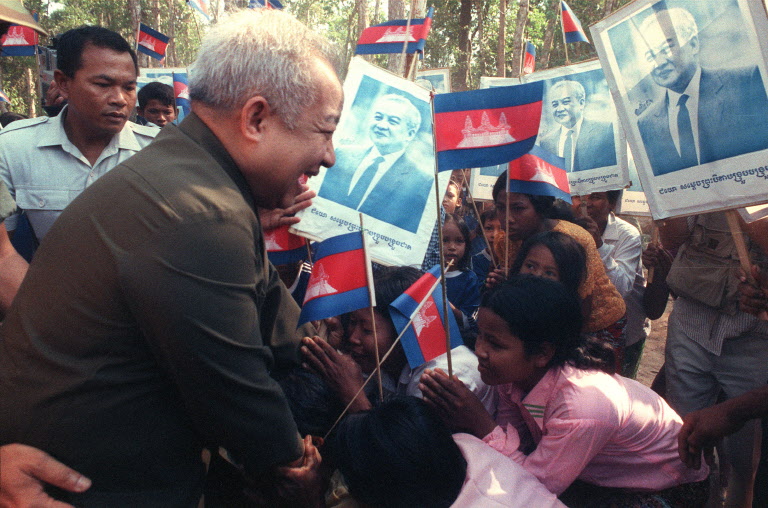 Prince Norodom Sihanouk is surrounded by people and the media as he tours communities near the Thai-Cambodian border. Photo: AFP
Prince Norodom Sihanouk is surrounded by people and the media as he tours communities near the Thai-Cambodian border. Photo: AFP
“Regionally, Vietnam supported Hun Sen, and the six ASEAN members of the time supported his opponents,” Evans said during a conference at the University of Melbourne in 2016. “And at the great power level, China supported the Khmer Rouge and Prince Sihanouk (as he then was); the Soviet Union supported Hun Sen; and the United States supported the two non-communist resistance groups.”
And in the middle were the Cambodians.
“Relief at the end of the Khmer Rouge has been replaced by fear of the present,” wrote in 1983 Dr. Steven Miles, medical director for the American Refugee Committee, about the Nong Samet Refugee Camp. Located near the Cambodian border, the camp had a population that varied between 45,000 and 70,000 people. “There is a hard hopelessness here, much more so than in the past,” he wrote. “Escape is not possible. Violence and corruption are pervasive. War is certain. Fear, a sense of extreme vulnerability, is the omnipresent emotion.”
Tony Jackson of the Oxfam’s research and evaluation unit wrote in June 1987, “[w]hereas previously people had been on the border but in Cambodia, they are now just inside Thailand. The whole Thai border is under martial law, and the refugees therefore come under the authority of the Thai military. In addition, all the camps are now closed areas, with access in and out extremely difficult, except for soldiers and black marketeers.
“Since the Royal Thai government only recognizes the Khmer as displaced persons and not refugees, they have effectively been deprived of any formal human rights…this has enormous negative consequences on inmates of the camps,” he wrote, adding that it was the majority of the Cambodians who were in that situation. According to observers, he wrote, the Thai government did not want to close these camps supported by guerrilla groups and move the refugees to safer non-Khmer Rouge locations because the government wanted the groups to receive aid.
“People live virtually like hostages while the coalition government is dominated by the Khmer Rouge who committed mass murder,” Jackson wrote. “[W]ith the superpowers disinterested in the issue, only volunteer agencies can act as a voice for the refugees.” Unlike people at the Khao-I-Dang Holding Center administered by the United Nations High Commissioner for Refugees, Cambodians in those camps did not have refugee status.
Moreover, “Cambodia itself receives virtually no official development aid since [the former Khmer Rouge now based in Thailand] is the recognized government,” Jackson said.
“Inside the country, only some United Nations agencies can bring aid such as UNICEF and the International Committee of the Red Cross,” said Raoul Jennar, adding that the World Health Organization was not allowed to do so. “No country has been imposed isolation to that extent since 1945,” he said in his book “Les cles du Cambodge” (the keys for Cambodia)—an analyst and political scientist, he worked with NGOs and the United Nations in Cambodia in the 1980s and 1990s.
“Western countries punish Cambodians for having been liberated from one of the most barbaric regimes of the century by Vietnam,” he wrote. Aid in Cambodia was being provided by the Soviet Union and countries that were part of the Eastern Bloc.
The end of the conflict and the return to normalcy
In September 1989, the last Vietnamese soldiers officially left the country.
And on Dec. 31, 1991, the Soviet Union was officially dissolved.
In Cambodia, it took the efforts of numerous people for peace to return to the country.
Among others, Pung Chhiv Kek whose mother had been Prince Sihanouk’s health minister in the mid-1960s and who had met Hun Sen through her French diplomat husband Jean-Jacques Galabru, would negotiate the first meetings between Prince Sihanouk and Hun Sen, president of the Council of Ministers at the time, which took place in France in December 1987 and January 1988. And Indonesian Foreign Minister Ali Alatas organized an informal meeting of the Cambodian factions in July 1988 and would co-preside with French Foreign Minister Roland Dumas the Paris Conference on Cambodia and the signing of the Paris Peace Agreements in October 1991 that officially put an end to the conflict in Cambodia.
 Ambassador Julio Jeldres, left, and Prince Norodom Sihanouk go through papers during a meeting in June 1991 in Pattaya City in Thailand ahead of the Paris Conference on Cambodia to be held October 1991. Photo: Ambassador Julio Jeldres collection
Ambassador Julio Jeldres, left, and Prince Norodom Sihanouk go through papers during a meeting in June 1991 in Pattaya City in Thailand ahead of the Paris Conference on Cambodia to be held October 1991. Photo: Ambassador Julio Jeldres collection
By April 1993, it is believed that more than 350,000 Cambodian refugees had been repatriated.
As Prince Sihanouk had requested years earlier, the United Nations Transitional Authority in Cambodia (UNTAC) was established to hold the national elections and help the country recover from decades of war.
The national elections overseen by UNTAC were held in May 1993 and nearly 90 percent of the eligible voters cast their ballots.
The Funcinpec headed by Prince Norodom Ranarridh won the elections but the Cambodian People’s Party (CPP) of Hun Sen refused to give up power.
And following the promulgation of the constitution in September 1993, Prince Sihanouk was crowned king for the second time in his life—he had first been crowned in 1941 but abdicated in 1955 in order to enter politics.
And as a compromise, Prince Ranarridh was named first prime minister and Hun Sen second prime minister, which would lead to conflicts in the years to come.
The Khmer Rouge resumed hostilities in some parts of the country, and it would be many years before they would stop.
Still, Cambodia was no longer at war.
The king’s biographer
With King Sihanouk back in the palace in Phnom Penh with his staff and the return to normalcy, Julio Jeldres decided to go back to Australia in 1992, feeling that he was no longer needed.
He returned in September 1993 to attend King Sihanouk’s coronation ceremony and to open the Institute for Democracy. He had received seed money to do so from Gareth Evans and the Konrad Adenauer Foundation, he said. The institute whose director was political analyst Lao Mong Hay would organize lectures and voter’s information programs. It closed its doors in 2017.
During his next visit, King Sihanouk told Jeldres that he had appointed him his official biographer with the protocol rank of minister of state. And that his first task was to do a book on the royal palace coffee-table style, which could be given to visiting dignitaries.
In addition to this book, Jeldres, who has a doctorate in history from Monash University in Australia, has written several books including a family tree on the royal family from King Ang Duong until today, and more recently the book “Norodom Sihanouk & Zhou Enlai” on the relationship between the late king and the Chinese prime minister. His next project may be to publish the biography of King Sihanouk he has written.
“The thing is that I’m always in conflict with the other scholars because they have written about the Sihanouk they have not met, they have not worked with,” Jeldres said. “But I was living with him 24 hours a day in Pyongyang in North Korea, in Beijing, when we were travelling to foreign countries, and so on [in the 1980s]. I saw him in operation, I saw him during frustrating times. Sometimes he was quite desperate because things were not going the way he wanted [in the 1980s].
“I think that the king was totally dedicated to Cambodia,” Jeldres added.







